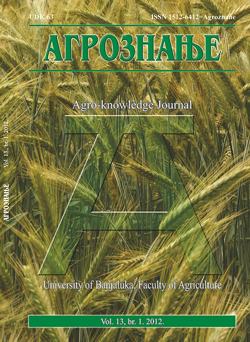Agronomic characteristics of winter oil rape hybrids depending of nitrogen top dressing
DOI:
https://doi.org/10.7251/AGREN1201135SAbstract
Oilseed rape is one of the most important sources of vegetable oil in the world. The nutrient demand of oilseed rape is considerably higher than that of cereals. Compared to cereals, winter oilseed rape requires more available nitrogen and this element is an important component with a strong effect on seed yield and quality, but it also affects the reduction of oil content. Winter oliseed rape hybrids with high yield potential might have high nitrogen requirements. On the other hand, the vigor of those plants might also be expressed as improved nitrogen uptake by a vigorous rooting system. In many cases, N fertilisation requirement does not take into account varietal types for Brassica napus L. Furthermore, it is based on fertiliser norm, with corrections according to environmental conditions. The objective of this study was to evaluate preliminary results of the influence of nitrogen top dressing on the yield and yield components of 8 winter oil rape hybrids and 2 winter oil rape cultivars. A field trial was carried out in village Gluvo (near Skopje) in 2010/2011. The experimental design was a split-plot with 3 replications and 3 nitrogen regimes as main factors. Fertiliser treatments were: N, N+120 kg N/ha, N + 120 + 70 kg N/ha. N treatment as a base fertiliser corresponded to 70 kg of N/ha. Two ammonium nitrate dressings were broadcast, first on 25 February and then on 15 March. It can be concluded from the results we obtained that twice applied top dressing had statistically significant differences (P = 0.05) on the yield of the hybrids/varieties, number of seed/pods and length of a pod (compared to one application and without top dressing), but did not significantly influence the height of a plant and number of primary branches/plant. On a hybrid/variety level, Hybrirock (KWS), Rohan (NPZ-Lembke) and Albatros (Limagrin) may be considered as the most promising for the Skopje region.Downloads
Published
2012-12-18
Issue
Section
Articles

